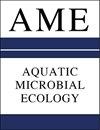Complementary chromatic acclimation by shifts in phycobiliprotein spectral absorption in the cryptophyte Hemiselmis pacifica
IF 1.1
4区 环境科学与生态学
Q3 ECOLOGY
引用次数: 0
Abstract
ABSTRACT: Cryptophytes are eukaryotic microalgae found in a variety of aquatic environments, from tea-colored ponds and lakes to the blue-water open ocean. To broaden the range of their spectral absorption beyond the limits of chlorophyll a, cryptophytes contain phycobiliprotein (PBP) accessory pigments. Hemiselmis pacifica contains the PBP cryptophyte-phycocyanin 577 (Cr-PC 577), which allows it to absorb green to orange wavelengths of light. Here, we characterized variability in PBP absorbance and growth rates of H. pacifica when this species was grown in nutrient-rich environments of differing spectral quality but equal light intensity. Two weeks after a shift from white to green light, H. pacifica altered the absorbance of its Cr-PC 577 to increase capture of green photons. Further, these complementary shifts were reversible when cultures were returned to the white-light environment, and the timescale of the reversal was faster than the original shift (~1 wk). Growth rates of H. pacifica in green light (0.25 d-1) were lower than in white-light controls (0.32 d-1), but not significantly different from cells grown in red light (0.27 d-1). The ability to adjust quickly to changes in light quality may confer an ecological advantage to cryptophytes when their environment is affected by processes such as eutrophication, deforestation/afforestation, or browning.隐花植物太平洋半知母(Hemiselmis pacifica)通过藻体脂蛋白光谱吸收的变化实现互补色度适应
摘要:隐藻是真核微藻,存在于各种水生环境中,从茶色池塘和湖泊到蓝水公海。为了扩大其光谱吸收范围,使其超出叶绿素 a 的限制,隐藻含有藻胆蛋白(PBP)附属色素。太平洋虹彩藻(Hemiselmis pacifica)含有 PBP 隐色体-植物花青素 577(Cr-PC 577),可吸收绿色至橙色波长的光。在这里,我们描述了在光谱质量不同但光照强度相同的富营养环境中生长的太平洋藻的 PBP 吸收率和生长率的变化。从白光转向绿光两周后,太平洋蜗牛改变了其 Cr-PC 577 的吸收率,以增加对绿色光子的捕获。此外,当培养物回到白光环境时,这些互补性转变是可逆的,而且逆转的时间尺度比原始转变快(约 1 周)。绿光(0.25 d-1)下太平洋鲎的生长率低于白光对照组(0.32 d-1),但与红光(0.27 d-1)下生长的细胞没有显著差异。当环境受到富营养化、森林砍伐/毁林或褐变等过程的影响时,隐花植物快速适应光质变化的能力可能会赋予其生态优势。
本文章由计算机程序翻译,如有差异,请以英文原文为准。
求助全文
约1分钟内获得全文
求助全文
来源期刊

Aquatic Microbial Ecology
环境科学-海洋与淡水生物学
CiteScore
3.30
自引率
0.00%
发文量
8
审稿时长
3.0 months
期刊介绍:
AME is international and interdisciplinary. It presents rigorously refereed and carefully selected Research Articles, Reviews and Notes, as well as Comments/Reply Comments (for details see AME 27:209), Opinion Pieces (previously called ''As I See It'') and AME Specials. For details consult the Guidelines for Authors. Papers may be concerned with:
Tolerances and responses of microorganisms to variations in abiotic and biotic components of their environment; microbial life under extreme environmental conditions (climate, temperature, pressure, osmolarity, redox, etc.).
Role of aquatic microorganisms in the production, transformation and decomposition of organic matter; flow patterns of energy and matter as these pass through microorganisms; population dynamics; trophic interrelationships; modelling, both theoretical and via computer simulation, of individual microorganisms and microbial populations; biodiversity.
Absorption and transformation of inorganic material; synthesis and transformation of organic material (autotrophic and heterotrophic); non-genetic and genetic adaptation; behaviour; molecular microbial ecology; symbioses.
 求助内容:
求助内容: 应助结果提醒方式:
应助结果提醒方式:


